Many VVS enthusiasts will be familiar with the striking types of camouflage and colour patterns which appeared on Soviet aircraft participating in various conflicts far away from eastern Europe-- in Spain, in China, in Manchuria, and so forth. However, it is arguably so that, in some local cases at least, there was an 'after effect' (if one will) of influence from this paintwork on VVS aircraft operating in the Great Patriotic War in the initial phase. It is likely the case that the main period in question extends roughly from the 1940 Camouflage Directives until the autumn of 1941.
Even earlier than 1940, actually, there was some anecdotal discussion of camouflage work which bore a 'Spanish influence'. Such work invariably was seen on examples of the SB, and some of these are quite striking. Without doubt, the appearance of many such appliqué schemes is hugely reminiscent of SB camouflage in Spain, and certainly must have been based upon those examples.
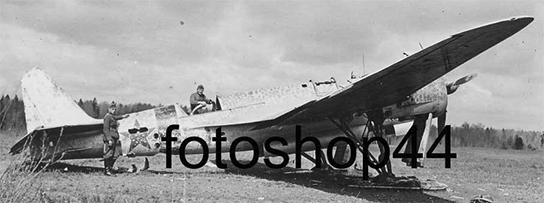
An unidentified SB captured by German forces during 1941
This SB is wearing a dapple appliqué scheme which is a virtual replica of some Spanish work of this type. The 'Spanish influence' here is unmistakable.
[Ed. My apologies-- the original image posted here was an SB in Spain. Small wonder it featured 'Spanish influence' in colouration, then. Please find a new example sporting the same influence from VVS service. Incompetence never takes a holiday, it seems...]
Manchurian Camouflage
During the Khalkin-Gol conflict against Japan (May-September 1939), the local VVS units in the Far East theatre developed an extraordinary camouflage repertoire. For reasons unknown, aviation lacquers AEh-9 Grey and AEh-15 Green were seized upon with such intensity that one might even refer to their use at the time as "nearly obsessive". Equally, the manner in which these paints were applied to the various aircraft was of unprecedented form and complexity. Indeed, it is quite possible that every permutation of camouflage patternation noted during the Second World War might have been seen on VVS aircraft in Manchuria-- the photographic record of these aircraft is utterly remarkable.
Even a cursory examination of such camougflage is beyond the scope of any article (requiring several books on the topic, one might suspect). Readers are recommended to examine such works as V. Kondrat'ev's "Khalkin-Gol-- War In the Air" (Tekhnika-Molodezhiy 2002), amongst others, which feature some outstanding photographic examples of these schemes. Suffice to say here that the use of lacquer AEh-9 and AEh-15 are paramount in this record.
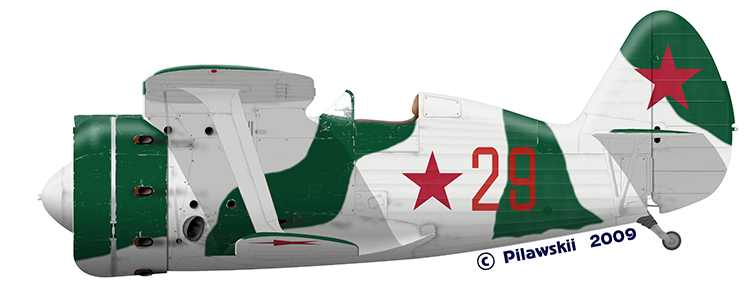
An early I-153 M-62 of the 56 IAP, taken from a photo in M. Maslov's collection. The finish consisted of hand-applied
disruptive bands of AEh-15 over AEh-9.
Indeed, it is exactly this type of segmented, or 'banded', application of camouflage in Khalkin-Gol (as opposed to the myriad other forms) in which we are interested, so far as our subject is concerned. There are a few known images in the photographic record showing this type of field applied camouflage. Invariably, such images were of German origin, showing machines which were downed or abandoned. The fact that we rarely see Soviet produced photographs with such schemes in view highlights the extemporaneous nature of these applications.
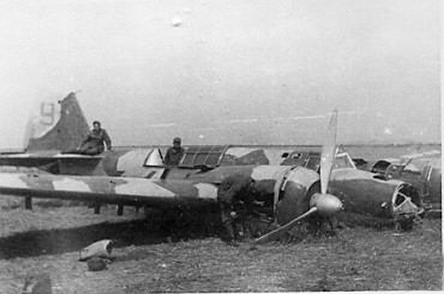
Crashed SB demonstrating what looks to be Manchurian styled appliqué camouflage
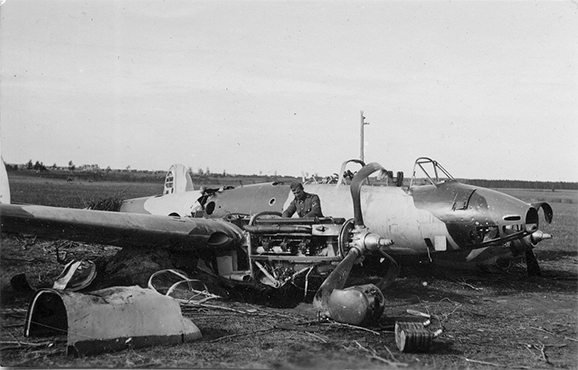
In these two photographs we see what one might refer to as 'Manchurian influenced' camouflage. The SB looks to have been finished either in AEh-9-- or perhaps AEh-8-- lacquer, with areas of a darker colour applied in segments over this. German images are notoriously difficult to analyse, but we can say that the tone of this darker colour certainly suggests (in any case) the appearance of AEh-15 Green. The 'angular' nature of the appliqué is in keeping with several Khalkin-Gol examples, appearing not only on local SBs but also an R-5 and an I-152 (for example).
The crashed Pe-2 demonstarates a three-colour permutation of this idea. The base colour on the machine looks to be the usual AII Green finish, with areas of what certainly look like AEh-9 and AEh-15 applied over this. The patternation and application are certainly local, and interestingly similar to our subject, "White 24". Note the very sharp colour demarcations.
White 24
Pe-2 "White 24" looks to have been photographed some time after its demise. The paintwork is suffering in some places-- revealing mid-tone characteristics underneath-- and the fabric looks to be missing from the various control surfaces. However, the three-colour scheme in view is again of decidedly Khalkin-Gol influence. The finishes used in the appliqué work on "24" look again to have been AEh-9 and AEh-15, these used in a bit more 'organic' patternation more in keeping with usual VVS practices. The colour demarcations were again quite hard.
It has been suggested that the darker colour around the number "24" could represent a fourth colour. This is possible, of course, but in my judgement this appearance is agreement with that of the centrally applied darker area. The slight shift in tone could be explained by myriad causes, not least of all problems on the image, or by a slightly more opaque application of paint on that section of the aircraft. Most likely, however, the red lens filter has simply amplified the contrast of the tones over the lighter section of the scheme, as such a device would be expected to do.
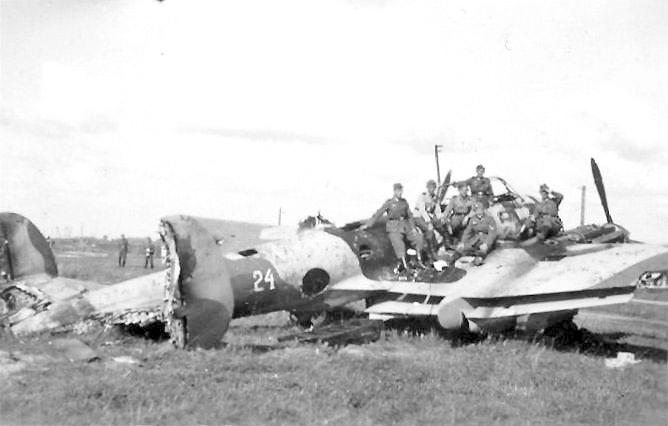
disruptive bands of AEh-15 over AEh-9.
Indeed, it is exactly this type of segmented, or 'banded', application of camouflage in Khalkin-Gol (as opposed to the myriad other forms) in which we are interested, so far as our subject is concerned. There are a few known images in the photographic record showing this type of field applied camouflage. Invariably, such images were of German origin, showing machines which were downed or abandoned. The fact that we rarely see Soviet produced photographs with such schemes in view highlights the extemporaneous nature of these applications.

Crashed SB demonstrating what looks to be Manchurian styled appliqué camouflage

An unknown Pe-2 with a three-colour field applied scheme. Once again, the favoured Khalkin-Gol
colours of AEh-9 and AEh-15 appear to have been used over a base of A2 Green.
colours of AEh-9 and AEh-15 appear to have been used over a base of A2 Green.
In these two photographs we see what one might refer to as 'Manchurian influenced' camouflage. The SB looks to have been finished either in AEh-9-- or perhaps AEh-8-- lacquer, with areas of a darker colour applied in segments over this. German images are notoriously difficult to analyse, but we can say that the tone of this darker colour certainly suggests (in any case) the appearance of AEh-15 Green. The 'angular' nature of the appliqué is in keeping with several Khalkin-Gol examples, appearing not only on local SBs but also an R-5 and an I-152 (for example).
The crashed Pe-2 demonstarates a three-colour permutation of this idea. The base colour on the machine looks to be the usual AII Green finish, with areas of what certainly look like AEh-9 and AEh-15 applied over this. The patternation and application are certainly local, and interestingly similar to our subject, "White 24". Note the very sharp colour demarcations.
White 24
Pe-2 "White 24" looks to have been photographed some time after its demise. The paintwork is suffering in some places-- revealing mid-tone characteristics underneath-- and the fabric looks to be missing from the various control surfaces. However, the three-colour scheme in view is again of decidedly Khalkin-Gol influence. The finishes used in the appliqué work on "24" look again to have been AEh-9 and AEh-15, these used in a bit more 'organic' patternation more in keeping with usual VVS practices. The colour demarcations were again quite hard.
It has been suggested that the darker colour around the number "24" could represent a fourth colour. This is possible, of course, but in my judgement this appearance is agreement with that of the centrally applied darker area. The slight shift in tone could be explained by myriad causes, not least of all problems on the image, or by a slightly more opaque application of paint on that section of the aircraft. Most likely, however, the red lens filter has simply amplified the contrast of the tones over the lighter section of the scheme, as such a device would be expected to do.

"White 24" as photographed by German forces. No date for the photo is given, but one might assume 'autumn 1941'
as a likely possibility.
as a likely possibility.
The resulting colour profile of "White 24" is, by necessity, a reconstruction. Many areas of the subject are either missing or hidden from view. The attempt here is to render a plausible appearance for "24" whilst in service. Alas, the fuselage is not in view to see if a national star marking could be present on the aft section, and so none has been applied to the artwork.

Noting the various details which are in view, this Pe-2 looks to have been roughly from Series 50, or thereabout. The profile was completed thusly, with ShKAS defensive guns in both places, slightly rounded spinners, and other details relevant to this period of manufacture. The aft cockpit fairing is shown in the retracted position.
Overall, "White 24" presents an attractive scheme, one which most certainly resembles the colouration practices seen in Khalkin-Gol. It is another fascinating example of local camouflage in the early Barbarossa period.
~